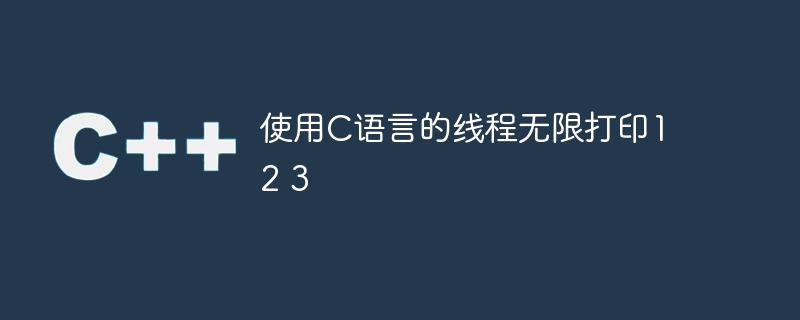使用C语言的线程无限打印1 2 3
- WBOYWBOYWBOYWBOYWBOYWBOYWBOYWBOYWBOYWBOYWBOYWBOYWB转载
- 2023-08-29 08:17:021209浏览

在这里,我们需要使用C编程语言中的线程无限次地重复打印1 2 3序列。
让我们来看看我们代码的样本输出:
1 2 3 1 2 3 1 2 3 1 2 3
为此,我们将需要使用三个在C编程语言中并行运行的线程。还需要一个变量,在第一个线程中初始化为1,并根据其上一个值更新其值。然后在函数中运行一个无限循环。
示例
让我们看看实现我们解决方案的程序:
#include <stdio.h>
#include <pthread.h>
pthread_cond_t cond1 = PTHREAD_COND_INITIALIZER;
pthread_cond_t cond2 = PTHREAD_COND_INITIALIZER;
pthread_cond_t cond3 = PTHREAD_COND_INITIALIZER;
pthread_mutex_t lock = PTHREAD_MUTEX_INITIALIZER;
int value = 1;
void *foo(void *n){
while(1) {
pthread_mutex_lock(&lock);
if (value != (int)*(int*)n) {
if ((int)*(int*)n == 1) {
pthread_cond_wait(&cond1, &lock);
} else if ((int)*(int*)n == 2) {
pthread_cond_wait(&cond2, &lock);
} else {
pthread_cond_wait(&cond3, &lock);
}
}
printf("%d ", *(int*)n);
if (value == 3) {
value = 1;
pthread_cond_signal(&cond1);
}
else if(value == 1) {
value = 2;
pthread_cond_signal(&cond2);
} else if (value == 2) {
value = 3;
pthread_cond_signal(&cond3);
}
pthread_mutex_unlock(&lock);
}
return NULL;
}
int main(){
pthread_t tid1, tid2, tid3;
int n1 = 1, n2 = 2, n3 = 3;
pthread_create(&tid1, NULL, foo, (void *)&n1);
pthread_create(&tid2, NULL, foo, (void *)&n2);
pthread_create(&tid3, NULL, foo, (void *)&n3);
while(1);
return 0;
}输出
1 2 3 1 2 3 1 2 3 1 2 3 1 2 3….
以上是使用C语言的线程无限打印1 2 3的详细内容。更多信息请关注PHP中文网其他相关文章!
声明:
本文转载于:tutorialspoint.com。如有侵权,请联系admin@php.cn删除
上一篇:如何使用C语言打印数字范围?下一篇:C程序找零钱

